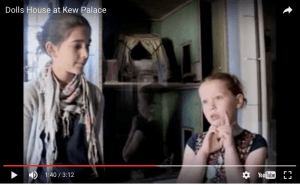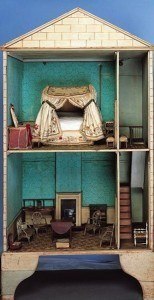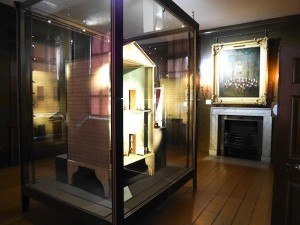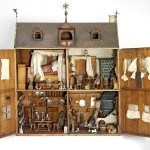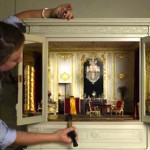Kew Palace, Embroidered bed from a doll’s house built in the 1780s for the daughters of King George III
Kew Palace Doll’s House
The doll’s house of Kew Palace was made around 1780 by the carpenter on board the Royal Yacht for the young daughters of King George III. I can imagine bored children needing the distraction while the adults enjoyed a leisurely cruise down the Thames and the Estuary.
The princesses would have played with this baby house until possibly outgrowing it in the mid-1790s when they gave it to the children of the Flag Captain on the King’s yacht, Sir George Grey. He sent it ashore to his home in Weymouth.
Rare Survivor
Princess Mary wrote about a doll’s house at Kew Palace, and it is very likely that this is the same one. If so, it is a rare survivor from the Georgian period and remarkably, most of its original features and furnishings – some of which were made by the young princesses – remain intact. The princesses, particularly Sophia and Amelia were known to have been skilled needleworkers, and the embroidered hangings certainly bear stylistic comparisons with an example of Amelia’s work in a display case in Kew Palace, next to the doll’s house.
A Toy, Not A Replica
The doll’s house provides an insight into how the royal princesses’ viewed the interiors of Kew Palace, wanting to give a child’s indication in their baby house without fretting much over details.
Wallpaper: both the house and the palace have blue/green wallpaper; the paper in the house is patterned, and that of the palace is plain.
Dark chocolate brown skirting boards are found in both.
Wheel back chairs painted green and white were originally found in both, but have been removed from the palace.
Grained wood is found in doors and chair rails of both.
The dressing table in the doll’s house resembles that pictured in the Zoffany painting of Queen Charlotte with her two eldest sons as young children.
Doll’s house bed: Wonderfully handmade tufted mattresses and embroidered bed hangings.
Rediscovered
The curators at Kew Palace were unaware of the existence of the doll’s house until they were tipped that a private collector had been attempting to sell it at various auctions for over a decade. It ended up with a New York art dealer, who was still looking for a suitable buyer.
The doll’s house and furniture have required some conservation work, as would be expected with any piece several hundred years old, that was used as a toy.
Restoration Tip
Saliva has been used to gently clean the interior wallpaper of the house. Containing no chemicals, saliva is sympathetic to the delicate paper surfaces, removing the grime and dirt, but not the historic paper and ink.
How about that?
Susan Downing, with Patrick Owens
_________________________________________________________________________
I invite you to visit my Etsy Shop where I offer many accessories and pieces of furniture in 1:12 scale.



